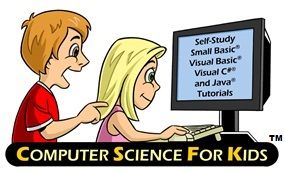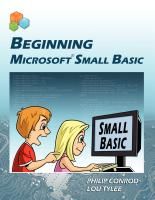
Computer Science For Kids "offers self study Programming Tutorials for Middle School, High School, and beginning adults. They have been in business for over 25 years. Each of their tutorials are beginner friendly and easy to understand and feature non violent computer games to teach kids programming in a fun way. As a member of the Schoolhouse Review Crew, I was given an opportunity to use and review Beginning Microsoft Small Basic.

The Beginning Microsoft Small Basic programming tutorial is an 11 chapter tutorial that teaches beginners ages 10 and up how to build Small Basic applications and compare them to other programming languages. It is presented using actual Small Basic examples and over 500 pages of course notes. Some of the detailed programs programs included to show how fun Small Basic can be include: number guessing game, card game, state capitals game, Tic-tac-toe, drawing program, logic game, savings calculator, and a basic video game. The source code for four classic Small Basic Games: Acey-Ducey, Even Wins, Mugwumps, and Lunar Lander are included in Class 11 of the tutorial.
You do not need to have any programming experience to use this course as each chapter is written in easy to follow step by step instructions. Some basic knowledge about computers like using the internet, opening and closing programs on your computer is required. You need to be able to view and print documents in Microsoft Word format. The course requires Windows XP-SP2, Vista, or Windows 7. You also need to download Microsoft Small Basic onto you computer (don't worry this is also explained in step by step format.)
Chapters Include:
Class 1-Introducing Small Basic
Class 2- Small Basic Program Basics
Class 3-Your First Small Basic Program
Class 4- Small Basic Program Designs
Class 5- Debugging, Decisions, Random Numbers
Class 6- Small Basic Looping, Subroutines
Class 7- More Small Basic Looping, Arrays
Class 8- Small Basic Graphics, Mouse Methods
Class 9-Timers, Animation, Keyboard Methods
Class 10- More Small Basic Programs
Class 11- Porting Small Basic Computer Games
You can view a sample chapter by clicking here.
The course is self paced with the suggested approach being to complete one class a week for 10 weeks. Each week's class should take around 3-6 hours to completely understand. You complete each example that is explained step by step working through all the programs in the chapter. All of the completed programs are included in the BSB folder that comes with the download.
The cost for an Instant Internet Digital Download E-book Edition Single User License is normally $59.95, but is on sale through July 4th 2013 for $34.95. A paperback textbook plus e-tutorial E-book download is $59.95. A School Site Teacher Edition is $199.95.
They also have a Computer Bible games for Microsoft Small Basic program that is very similar to the Beginning Small Basic program. The first 10 chapters are exactly the same, but the three final chapters have tutorials for classic Bible games.
I have to confess, I was completely intimidated when I found out I was going to be reviewing this product. I do have some basic computer knowledge, mostly downloading and opening programs and skills required to write this blog, but I had never done anything like this before, and I was afraid that because of that, I would not be able to help my 16 year old with this program. But, it has been much easier than I expected! We are using Beginning Small Basic on our Windows 7 laptop. We had to download the zip file and extract the folders. We did not have Microsoft Small Basic on the computer so we had to download it, but the tutorial tells you exactly what to do ,step by step. It was very easy to download and open.
Once Microsoft Small Basic is downloaded, that is what you use to write your code. You need to open Small Basic. Then you type in what the lesson tells you. The lessons are found in the file you downloaded and extracted BSB notes. Small Basic has a program feature called Intellisense that allows you to type your code faster. For instance, if you need to have the word Text in your code and you press the "T" a box will pop up and you click the word text and hit enter instead of having to type it out. The program is not case sensitive, you just need to spell the words you need correctly. Once you have everything entered, you hit run and another window pops up with the program that you wrote. If you have made an error in your code, the program will tell you where the error occurred by line number and character so you can find it and fix it. The program also provides "context sensitive" help in which the help area will show information that is important to the user at that time. You can also save your programs or even publish them to the web and share with friends and family.
I started off (after reading the start here directions) by printing off the first lesson. But, it was fairly long and had colored pictures and I did not want to waste the ink in my printer, so the rest of the lessons I put on the iPad for Chelsea to read off of. She has had great success and has not needed any assistance at all. She has been doing one lesson per week. The first three lessons she moved through fairly quickly but the last two have become more involved and are taking longer. She was very proud of herself when she but the information in and her program ran! She has become very confident of her programming abilities and has really enjoyed working through the lessons.
To see what other Crew Mates had to say, click on the banner below.






No comments:
Post a Comment